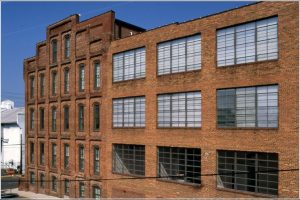|
|
Student Corner: Historic mill redevelopment — Renfro Mill (Mt. Airy, NC)By CED Program Interns & StudentsPublished March 21, 2013
Renfro Mill, Mt. Airy, North Carolina (pop. 10,400) Built in 1892 in downtown Mt. Airy, the Mill was originally a tobacco leaf plant and later became a sock manufacturing facility. The Mill closed in the 1990s and sat vacant for years, until its renovation in 2002. The project involved converting 100,000 square feet of manufacturing space into 37 high end residential condominiums. The project cost was approximately $6 million to renovate, and the Historic tax credits were passed through to the buyers of the condominiums. The Impact: This project has encouraged the renovation of neighboring streets and buildings. The tax value of this once vacant property currently exceeds $6 million and the resale price of units has increased by nearly 40%. According to a report from Preservation North Carolina, “this is possibly the first project in North Carolina in which the state and federal tax credits were passed through the developer to the end buyers. This “pass through” allowed the project to be owner occupied (as opposed to rental) and for each condominium buyer to receive the benefit of the state preservation credits. This incentive, coupled with high-end renovation resulted in a preconstruction sell out of the entire project within 120 days. The downtown now has 37 higher income families living in the downtown, shopping, eating, and using the downtown services.” (1) (1) Ted Alexander, Lynn Cowan, with assistance from Diane Althouse. Industrial Properties Rehabilitation Case Studies, 2005. Available here. Photo Credit: Alexander, Cowan, Althouse, Industrial Properties Rehabilitation Case Studies, 2005. Emily Dorfman is a MBA student at UNC’s Kenan Flagler Business School. |
Published March 21, 2013 By CED Program Interns & Students
 As has been described in previous posts (here and here), Historic and Mills Bill tax credits have been important tools for redevelopment across North Carolina. Redevelopment of an historic structure can serve as a catalyst for revitalization and economic development in communities of all sizes. Mills and other abandoned manufacturing facilities dot the landscape of small towns across North Carolina. One reason that historic mill buildings sit vacant is that redevelopment costs can exceed the value of the property or the cost of a brand new development, and with that the amount of money a bank will lend or an investor will commit to a project. Tax credits increase the financial feasibility of redevelopment projects on historic or mill properties.
As has been described in previous posts (here and here), Historic and Mills Bill tax credits have been important tools for redevelopment across North Carolina. Redevelopment of an historic structure can serve as a catalyst for revitalization and economic development in communities of all sizes. Mills and other abandoned manufacturing facilities dot the landscape of small towns across North Carolina. One reason that historic mill buildings sit vacant is that redevelopment costs can exceed the value of the property or the cost of a brand new development, and with that the amount of money a bank will lend or an investor will commit to a project. Tax credits increase the financial feasibility of redevelopment projects on historic or mill properties.
Renfro Mill, Mt. Airy, North Carolina (pop. 10,400)
Built in 1892 in downtown Mt. Airy, the Mill was originally a tobacco leaf plant and later became a sock manufacturing facility. The Mill closed in the 1990s and sat vacant for years, until its renovation in 2002. The project involved converting 100,000 square feet of manufacturing space into 37 high end residential condominiums. The project cost was approximately $6 million to renovate, and the Historic tax credits were passed through to the buyers of the condominiums.
The Impact: This project has encouraged the renovation of neighboring streets and buildings. The tax value of this once vacant property currently exceeds $6 million and the resale price of units has increased by nearly 40%. According to a report from Preservation North Carolina, “this is possibly the first project in North Carolina in which the state and federal tax credits were passed through the developer to the end buyers. This “pass through” allowed the project to be owner occupied (as opposed to rental) and for each condominium buyer to receive the benefit of the state preservation credits. This incentive, coupled with high-end renovation resulted in a preconstruction sell out of the entire project within 120 days. The downtown now has 37 higher income families living in the downtown, shopping, eating, and using the downtown services.” (1)
(1) Ted Alexander, Lynn Cowan, with assistance from Diane Althouse. Industrial Properties Rehabilitation Case Studies, 2005. Available here.
Photo Credit: Alexander, Cowan, Althouse, Industrial Properties Rehabilitation Case Studies, 2005.
Emily Dorfman is a MBA student at UNC’s Kenan Flagler Business School.
Author(s)
Tagged Under
This blog post is published and posted online by the School of Government to address issues of interest to government officials. This blog post is for educational and informational Copyright ©️ 2009 to present School of Government at the University of North Carolina. All rights reserved. use and may be used for those purposes without permission by providing acknowledgment of its source. Use of this blog post for commercial purposes is prohibited. To browse a complete catalog of School of Government publications, please visit the School’s website at www.sog.unc.edu or contact the Bookstore, School of Government, CB# 3330 Knapp-Sanders Building, UNC Chapel Hill, Chapel Hill, NC 27599-3330; e-mail sales@sog.unc.edu; telephone 919.966.4119; or fax 919.962.2707.

